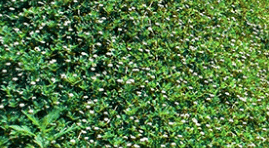Have you ever dreamed of having a lush garden with green and healthy turf? But what if you live in a hot and dry region, where taking care of a lawn can be challenging?
We have good news for you! You can try Kurapia, a drought-tolerant and relatively easy-to-care-for alternative to grass.
And the best part about it is that it allows you to enjoy turf (or something that resembles it) without mowing it once or twice per week!
Does that sound intriguing? Read on to learn more about Kurapia grass and what you should do to make the most out of it!
What Is Kurapia Grass?
Despite its name, Kurapia isn’t a type of grass. Instead, it is more of a ground cover that doesn’t require mowing and drinks up to 60% less water than your regular lawn. This plant is part of the Verbenaceae family and comes from a Phyla variety native to Japan.
Kurapia Grass results from the efforts of a Japanese scientist looking for a hardy plant that will help maintain beautiful landscapes without needing as much water as regular turf.
Today, this non-invasive and low-growing flowering plant is becoming a trendy option for gardens in the Southern states because of its durability and growing characteristics.
Indeed, thanks to its deep taproots, Kurapia Grass tolerates drought and will spread rapidly under optimal growing conditions. But beware: it will perform best only if it receives minimal foot traffic.
And if things couldn’t get better than that, you might be happy to hear that this ground cover will improve the looks of your garden from May through October, when this plant blooms. This plant’s flowers will make your garden lively and assist other plants with pollination.
Who Might Benefit from Planting Kurapia Grass?
Because of its characteristics, Kurapia grass is an excellent alternative to turf. This perennial ground cover will improve the looks of any garden and doesn’t require much maintenance. And for those who hate the idea of mowing, this plant will be the ideal option to add greenery to their yard.
While the price might scare some people away, its low maintenance requirements make Kurapia grass an attractive option for gardeners willing to enjoy a lush garden without spending too much effort on it. Consider the initial cost as an investment to have a healthy garden! But who might benefit from installing Kurapia Grass?
This plant is suitable to use in residential and commercial landscapes. For instance, it is now a popular option for covering highway and freeways shoulders, rooftops, parks, and private properties. And the best part is that it doesn’t require much attention to grow.
Also, if you need a solution to erosion, you must consider planting Kurapia. Once established, this plant will also contribute to weed suppression.
This plant performs well even in areas that are hard to maintain and that receive challenging amounts of sunlight or heat. And it will also grow in shady areas. If you live in an area where droughts are not unheard of, you will, for sure, love Kurapia grass.
This plant ensures considerable water savings and, once established, it will maintain its green color all year round.
But what can you do to grow and maintain Kurapia Grass in your yard? Jump to the following section to learn all you need to know about it!
How to Grow Kurapia Grass
Kurapia grass thrives in a variety of conditions. However, it prefers loamy and well-draining soil. If you have a more compact substrate, amend it by adding some worm casting on top. Doing so will also improve water retention. And if you are dealing with clay ground, consider tilting it to increase aeration and recreate the optimal conditions for the plant to establish.
This plant does well in a variety of climates. But keep in mind that warmer conditions are ideal, especially if you are looking for a fast-growing plant that will provide full coverage in a few months.
Heavily water the plant after you install it to boost its establishment. After that, add extra moisture to your ground cover about once a week to keep it extra lush. If, for some reason, you forget to water it, don’t worry: you might not see any browning for a couple of months.
Fertilization isn’t necessary, but it may help to retail color. Consider adding a balanced product in the fall to boost growth over the following season.
While mowing isn’t necessary, you should consider cutting the grass when it reaches around two inches tall. It will reduce excessive moisture buildup (and protect your plant from fungal infections) and keep it in shape.
Related Article: Best Ways to Remove Weeds From a Large Area

